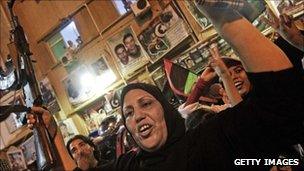Who, What, Why: How dangerous is firing a gun into the air?
- Published

Libyan rebels have celebrated their advance into Tripoli by firing guns in the air. How hazardous is this?
It is, unarguably, an emphatic way to display one's jubilation.
Shooting an automatic weapon into the sky to signal an occasion one welcomes is a popular practice in much of the world, as the footage of Libyan anti-Gaddafi forces seizing the main square of the capital city has demonstrated.
But it is a potentially fatal activity, which regularly results in the deaths of bystanders.
"These bullets go a long way up when they're fired," says ballistics expert David Dyson. "But you don't know where they're going to land - there's always a chance of them causing serious harm or death."
Examples of fatalities due to celebratory gunfire abound.
Three people in the Philippines died due to stray bullets fired to welcome the arrival of the new year 2011.
In 2010 a Turkish bridegroom killed three relatives when he fired an AK-47 at his own wedding. In the same year, Jordan's King Abdullah II ordered his country's authorities to clamp down on the practice after two people were killed and 13 more injured in one incident.
When the Iraqi football team defeated Vietnam in 2007's Asia Cup, three people were killed in Baghdad amid widespread gunshots as fans celebrated. Celebratory gunfire in Kuwait after the end of the Gulf War in 1991 was blamed for 20 deaths.
The practice is not restricted to Asia and the Middle East. A US study found that 118 people were treated for random "falling-bullet injuries" at one Los Angeles medical centre between 1985 and 1992, resulting in the deaths of 38.
Additionally, the government of the Former Yugoslav Republic of Macedonia also ran a poster campaign with the slogan "Bullets Are Not Greeting Cards - Celebrate Without Weapons". In 2005, Serbian authorities warned their citizens that "every bullet that is fired up must come down" ahead of New Year's Eve.
Studies suggest that, although the velocity of a falling bullet is lower than that of one which has just been fired, it is still sufficient to be fatal.
According to a 1962 study, .30 calibre rounds can reach terminal velocities of 300 feet (91m) per second as they fall. More recent research has indicated that 200 feet (61m) per second is enough to penetrate the skull.
As a result, a number of US states including California, Texas, Arizona and Ohio outlaw firing a gun into the air. In Minnesota, it is specifically forbidden in cemeteries.
Prof Peter Squires, an expert in gun crime and gun culture at the University of Brighton, says it is possible that the practice stems from cultural assumptions linking weapons with masculinity and ego.
But, additionally, he suggests that the common practice of firing 21-gun salutes or deploying firing parties at military funerals - albeit equipped with blanks - may have been somehow appropriated.
"There's an association with fireworks," he says. "Firing a gun is an effective way or making a loud bang. It's tied up with a state of carnivalesque abandon.
"But obviously what goes up must come down again."